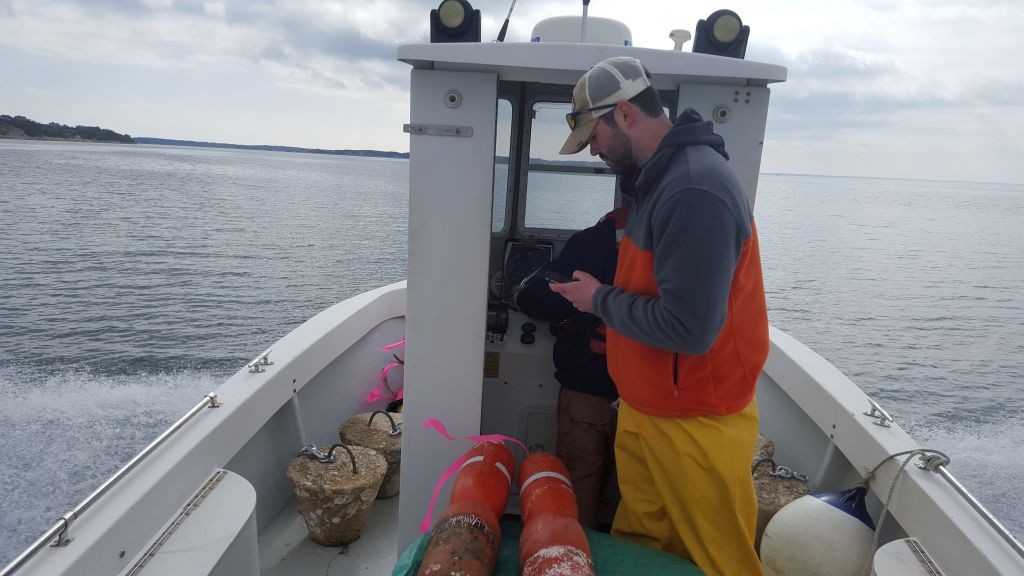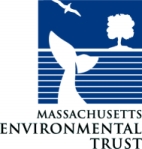As he downloaded data collected by receivers he deployed throughout Wellfleet Harbor last summer, horseshoe crab researcher Mike Long noticed the receivers had been “pinged” by IDs other than those belonging to his study crabs.

Photo by Elias Levy
It wasn’t until a conference in January that Mike began talking with state marine fisheries officials who ultimately helped determine the mystery pings were from tagged (great) white sharks. Sharks—in Wellfleet Harbor! Most of the detections were during early and late fall and not when the harbor was teeming with summer recreation.
Mike says 4 sharks were picked up by one or more of his receivers with one shark pinging all of them—“Making a full tour of the harbor,” he says. The finding was a surprise to shark researchers.
What did the receivers reveal about his horseshoe crab study, which began last spring? Mike says some crabs left the harbor a couple of weeks after spawning, some stayed around for a while before leaving, and some were still pinging in December when the receivers were pulled from the water for the winter.

Mike Long redeploys horseshoe crab receivers for second season of his research in Wellfleet Harbor (photo by Michael Sprague)
He’s hoping his research will provide a better understanding about the movement of Wellfleet’s horseshoe crabs and to what extent they come and go and potentially mix with crabs at other sites in Cape Cod Bay and beyond. The sanctuary has been concerned for some time that Wellfleet Harbor’s crabs are in steep decline. The amount of time crabs spend in the harbor can lead to more accurate estimates of population size, immigration, emigration, and mortality. These pieces of information can lead to more sustainable harvest quotas for Wellfleet Harbor and the state.
Mike knows at least some Wellfleet crabs have been on the move. Between June and December of last year, fifteen of his crabs pinged someone else’s receiver—one belonging to the state division of marine fisheries— located a few miles outside Wellfleet Harbor.
To exchange any future data received, the sanctuary plans to join a national research telemetry network , though Mike doesn’t expect to get much information from receivers outside of Massachusetts. “Horseshoe crabs are not one of the fastest animals in the world,” he notes.
If you’d like to learn more about horseshoe crabs and assist with scientific spawning surveys this spring, the sanctuary will be offering some training sessions in April. Anyone interested should contact volunteer coordinator Jackie Zwahlen by email or by calling 508-349-2615, extension 101.
Wellfleet Bay’s 2-year horseshoe crab study is funded by the Massachusetts Environmental Trust.



Hi, Grace,
So glad to hear about your activities at Bluff Point State Park. Data gathering is the first step toward making a case for conserving crabs! I forwarded your question about what constitutes sustainable harvest quotas to our researcher Mike Long. Here’s his reply:
Sustainable harvest quotas refer to the amount of horseshoe crabs that are caught in the commercial fishery. The Atlantic States Marine Fisheries Commission (ASMFC) regulates the horseshoe crab fishery for the entire east coast of the United States, and part of their management practice is to limit the number of crabs that can be caught and harvested in each state each year. Massachusetts has a state quota of 165,000 crabs per year.
If there are scientific surveys that show the abundance of horseshoe crabs is declining over a large geographic area and over long time scale, the ASMFC can reduce the harvest quotas for each state to ensure that horseshoe crabs do not become overfished. Vice versa, if surveys show that crab abundance is increasing over a large geographic area and over a long time scale, the ASMFC can raise the harvest quotas to allow for an increased harvest.
In essence, sustainable harvest quotas are simply a way to protect horseshoe crabs from being harvested too heavily. The same goes for all species that are caught in commercial fisheries in the United States. I hope this answers your question!
Michael Long
Although I would love to help out, realistically, Wellfleet is just too far from my home here in CT. But, I did sign up to receive blog notices as I am very interested in horsecrabs (I do tag and count them here at Bluff Point State Park. These surveys have been organized out of Sacred Heart University. Our counts also have been down which is troubling on so many levels. Was wondering about “sustainable harvest quotas” and what exactly this means.